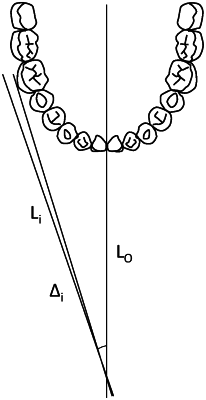| CPC A61C 7/002 (2013.01) [A61C 7/08 (2013.01); G06T 17/00 (2013.01); A61C 2007/004 (2013.01)] | 8 Claims |

|
1. A method for treating a patient's teeth to improve the patient's buccal corridor, the method comprising:
obtaining, in a computing system, a representation of the patient's dentition corresponding to a dental arch;
determining an initial measure of the patient's buccal corridor for the dental arch;
determining a target measure of the patient's buccal corridor for the dental arch, wherein determining the target measure of the patient's buccal corridor for the dental arch comprises determining, for at least some of the patient's teeth in the dental arch, an optimized tooth angle between a symmetry plane through a midline of the dental arch and a line from an assessment point on the symmetry plane at a pre-determined distance anterior to the dental arch, to a new position of the patient's tooth such that, for a given tooth: a visibility width of any tooth posterior to the given tooth is less than a visibility width of the given tooth; and the visibility widths of the patient's teeth from anterior to posterior decrease;
using the initial measure of the patient's buccal corridor and the target measure of the patient's buccal corridor to determine a treatment plan comprising a series of orthodontic aligners configured to incrementally move the patient's teeth through each stage of the series to improve the patient's buccal corridor to approximate the target measure of the patient's buccal corridor,
wherein using the initial measure of the patient's buccal corridor and the target measure of the patient's buccal corridor to determine a treatment plan comprises estimating a target dental arch model based on the optimized tooth angles;
outputting the treatment plan; and
generating one or more orthodontic aligners in the series of orthodontic aligners from the target dental arch model.
|